LLM2LLM: Boosting LLMs with Novel Iterative Data Enhancement

Pretrained large language models (LLMs) are currently state-of-the-art for solving the vast majority of natural language processing tasks. While many real-world applications still require fine-tuning to reach satisfactory levels of performance, many of them are in the low-data regime, making fine-tuning challenging. To address this, we propose LLM2LLM, a targeted and iterative data augmentation strategy that uses a teacher LLM to enhance a small seed dataset by augmenting additional data that can be used for fine-tuning on a specific task. LLM2LLM (1) fine-tunes a baseline student LLM on the initial seed data, (2) evaluates and extracts data points that the model gets wrong, and (3) uses a teacher LLM to generate synthetic data based on these incorrect data points, which are then added back into the training data. This approach amplifies the signal from incorrectly predicted data points by the LLM during training and reintegrates them into the dataset to focus on more challenging examples for the LLM. Our results show that LLM2LLM significantly enhances the performance of LLMs in the low-data regime, outperforming both traditional fine-tuning and other data augmentation baselines. LLM2LLM reduces the dependence on labor-intensive data curation and paves the way for more scalable and performant LLM solutions, allowing us to tackle data-constrained domains and tasks. We achieve improvements up to 24.2% on the GSM8K dataset, 32.6% on CaseHOLD, 32.0% on SNIPS, 52.6% on TREC and 39.8% on SST-2 over regular fine-tuning in the low-data regime using a LLaMA2-7B student model.
Can large language models explore in-context?
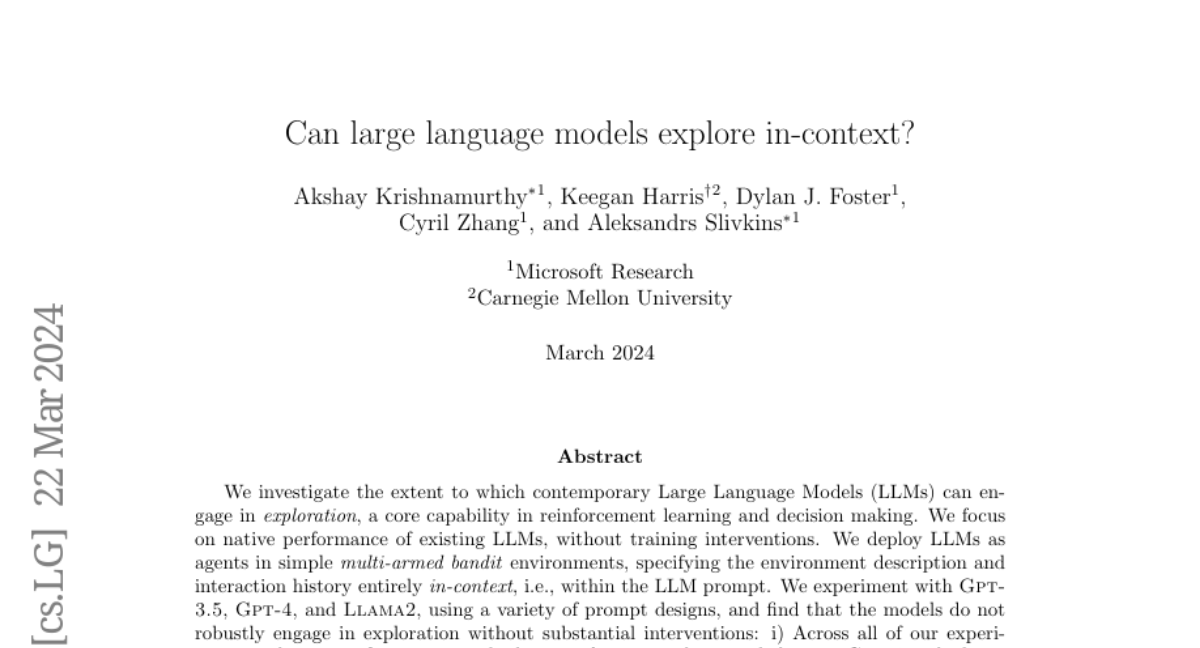
We investigate the extent to which contemporary Large Language Models (LLMs) can engage in exploration, a core capability in reinforcement learning and decision making. We focus on native performance of existing LLMs, without training interventions. We deploy LLMs as agents in simple multi-armed bandit environments, specifying the environment description and interaction history entirely in-context, i.e., within the LLM prompt. We experiment with GPT-3.5, GPT-4, and Llama2, using a variety of prompt designs, and find that the models do not robustly engage in exploration without substantial interventions: i) Across all of our experiments, only one configuration resulted in satisfactory exploratory behavior: GPT-4 with chain-of-thought reasoning and an externally summarized interaction history, presented as sufficient statistics; ii) All other configurations did not result in robust exploratory behavior, including those with chain-of-thought reasoning but unsummarized history. Although these findings can be interpreted positively, they suggest that external summarization -- which may not be possible in more complex settings -- is important for obtaining desirable behavior from LLM agents. We conclude that non-trivial algorithmic interventions, such as fine-tuning or dataset curation, may be required to empower LLM-based decision making agents in complex settings.
InternVideo2: Scaling Video Foundation Models for Multimodal Video Understanding

We introduce InternVideo2, a new video foundation model (ViFM) that achieves the state-of-the-art performance in action recognition, video-text tasks, and video-centric dialogue. Our approach employs a progressive training paradigm that unifies the different self- or weakly-supervised learning frameworks of masked video token reconstruction, cross-modal contrastive learning, and next token prediction. Different training stages would guide our model to capture different levels of structure and semantic information through different pretext tasks. At the data level, we prioritize the spatiotemporal consistency by semantically segmenting videos and generating video-audio-speech captions. This improves the alignment between video and text. We scale both data and model size for our InternVideo2. Through extensive experiments, we validate our designs and demonstrate the state-of-the-art performance on over 60 video and audio tasks. Notably, our model outperforms others on various video-related captioning, dialogue, and long video understanding benchmarks, highlighting its ability to reason and comprehend long temporal contexts. Code and models are available at https://github.com/OpenGVLab/InternVideo2/.
SiMBA: Simplified Mamba-Based Architecture for Vision and Multivariate Time series
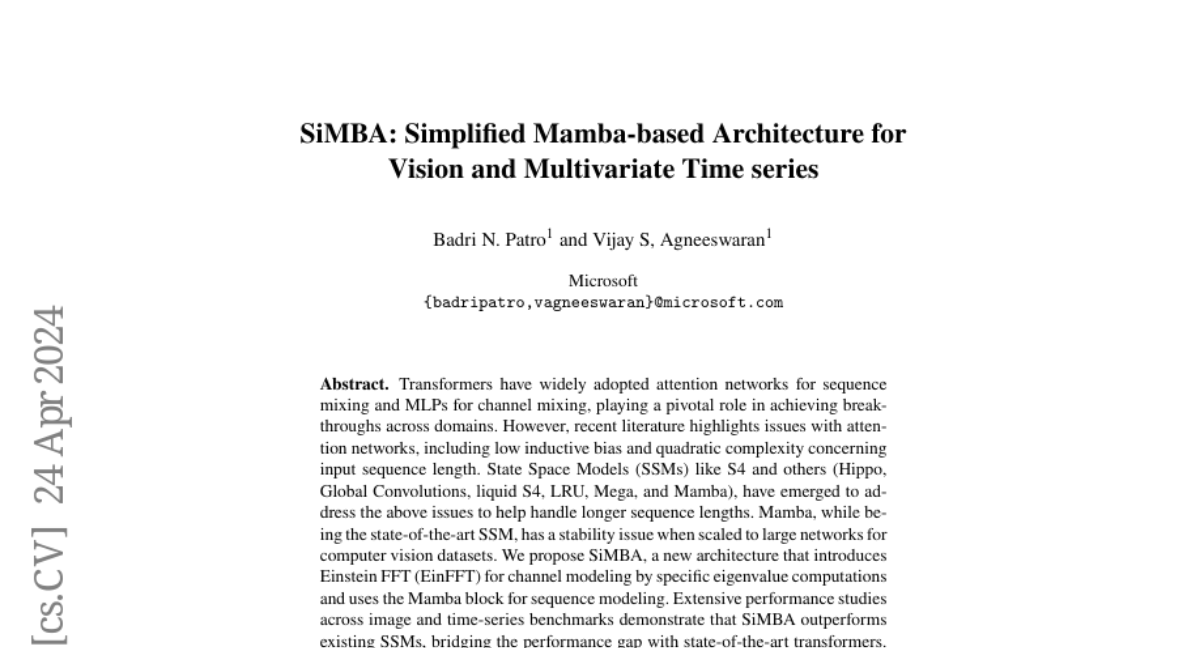
Transformers have widely adopted attention networks for sequence mixing and MLPs for channel mixing, playing a pivotal role in achieving breakthroughs across domains. However, recent literature highlights issues with attention networks, including low inductive bias and quadratic complexity concerning input sequence length. State Space Models (SSMs) like S4 and others (Hippo, Global Convolutions, liquid S4, LRU, Mega, and Mamba), have emerged to address the above issues to help handle longer sequence lengths. Mamba, while being the state-of-the-art SSM, has a stability issue when scaled to large networks for computer vision datasets. We propose SiMBA, a new architecture that introduces Einstein FFT (EinFFT) for channel modeling by specific eigenvalue computations and uses the Mamba block for sequence modeling. Extensive performance studies across image and time-series benchmarks demonstrate that SiMBA outperforms existing SSMs, bridging the performance gap with state-of-the-art transformers. Notably, SiMBA establishes itself as the new state-of-the-art SSM on ImageNet and transfer learning benchmarks such as Stanford Car and Flower as well as task learning benchmarks as well as seven time series benchmark datasets. The project page is available on this website ~\url{https://github.com/badripatro/Simba}.
StreamingT2V: Consistent, Dynamic, and Extendable Long Video Generation from Text
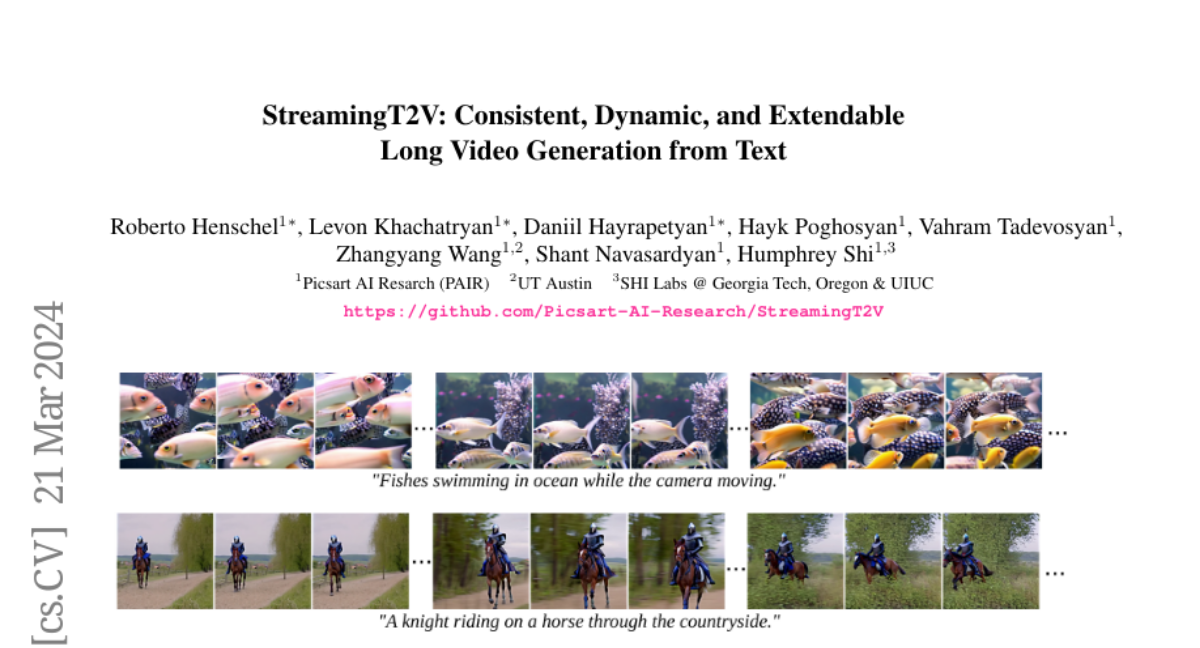
Text-to-video diffusion models enable the generation of high-quality videos that follow text instructions, making it easy to create diverse and individual content. However, existing approaches mostly focus on high-quality short video generation (typically 16 or 24 frames), ending up with hard-cuts when naively extended to the case of long video synthesis. To overcome these limitations, we introduce StreamingT2V, an autoregressive approach for long video generation of 80, 240, 600, 1200 or more frames with smooth transitions. The key components are:(i) a short-term memory block called conditional attention module (CAM), which conditions the current generation on the features extracted from the previous chunk via an attentional mechanism, leading to consistent chunk transitions, (ii) a long-term memory block called appearance preservation module, which extracts high-level scene and object features from the first video chunk to prevent the model from forgetting the initial scene, and (iii) a randomized blending approach that enables to apply a video enhancer autoregressively for infinitely long videos without inconsistencies between chunks. Experiments show that StreamingT2V generates high motion amount. In contrast, all competing image-to-video methods are prone to video stagnation when applied naively in an autoregressive manner. Thus, we propose with StreamingT2V a high-quality seamless text-to-long video generator that outperforms competitors with consistency and motion. Our code will be available at: https://github.com/Picsart-AI-Research/StreamingT2V
FollowIR: Evaluating and Teaching Information Retrieval Models to Follow Instructions

Modern Large Language Models (LLMs) are capable of following long and complex instructions that enable a diverse amount of user tasks. However, despite Information Retrieval (IR) models using LLMs as the backbone of their architectures, nearly all of them still only take queries as input, with no instructions. For the handful of recent models that do take instructions, it's unclear how they use them. We introduce our dataset FollowIR, which contains a rigorous instruction evaluation benchmark as well as a training set for helping IR models learn to better follow real-world instructions. FollowIR builds off the long history of the TREC conferences: as TREC provides human annotators with instructions (also known as narratives) to determine document relevance, so should IR models be able to understand and decide relevance based on these detailed instructions. Our evaluation benchmark starts with three deeply judged TREC collections and alters the annotator instructions, re-annotating relevant documents. Through this process, we can measure how well IR models follow instructions, through a new pairwise evaluation framework. Our results indicate that existing retrieval models fail to correctly use instructions, using them for basic keywords and struggling to understand long-form information. However, we show that it is possible for IR models to learn to follow complex instructions: our new FollowIR-7B model has significant improvements (over 13%) after fine-tuning on our training set.
VidLA: Video-Language Alignment at Scale

In this paper, we propose VidLA, an approach for video-language alignment at scale. There are two major limitations of previous video-language alignment approaches. First, they do not capture both short-range and long-range temporal dependencies and typically employ complex hierarchical deep network architectures that are hard to integrate with existing pretrained image-text foundation models. To effectively address this limitation, we instead keep the network architecture simple and use a set of data tokens that operate at different temporal resolutions in a hierarchical manner, accounting for the temporally hierarchical nature of videos. By employing a simple two-tower architecture, we are able to initialize our video-language model with pretrained image-text foundation models, thereby boosting the final performance. Second, existing video-language alignment works struggle due to the lack of semantically aligned large-scale training data. To overcome it, we leverage recent LLMs to curate the largest video-language dataset to date with better visual grounding. Furthermore, unlike existing video-text datasets which only contain short clips, our dataset is enriched with video clips of varying durations to aid our temporally hierarchical data tokens in extracting better representations at varying temporal scales. Overall, empirical results show that our proposed approach surpasses state-of-the-art methods on multiple retrieval benchmarks, especially on longer videos, and performs competitively on classification benchmarks.
LATTE3D: Large-scale Amortized Text-To-Enhanced3D Synthesis
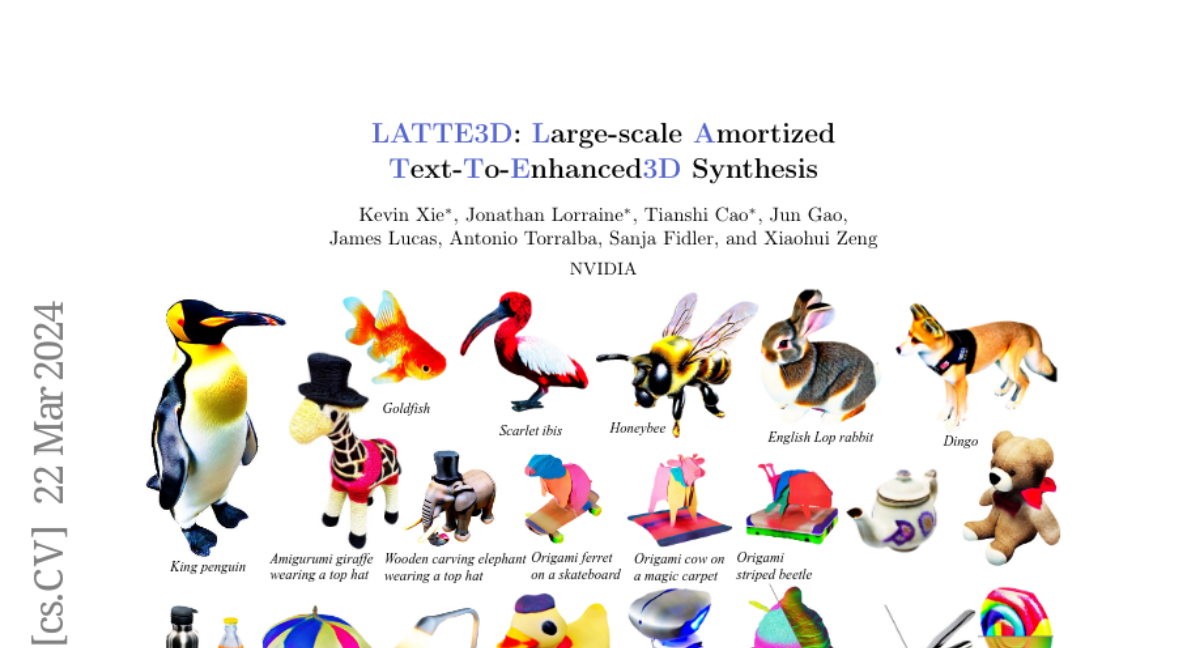
Recent text-to-3D generation approaches produce impressive 3D results but require time-consuming optimization that can take up to an hour per prompt. Amortized methods like ATT3D optimize multiple prompts simultaneously to improve efficiency, enabling fast text-to-3D synthesis. However, they cannot capture high-frequency geometry and texture details and struggle to scale to large prompt sets, so they generalize poorly. We introduce LATTE3D, addressing these limitations to achieve fast, high-quality generation on a significantly larger prompt set. Key to our method is 1) building a scalable architecture and 2) leveraging 3D data during optimization through 3D-aware diffusion priors, shape regularization, and model initialization to achieve robustness to diverse and complex training prompts. LATTE3D amortizes both neural field and textured surface generation to produce highly detailed textured meshes in a single forward pass. LATTE3D generates 3D objects in 400ms, and can be further enhanced with fast test-time optimization.
ThemeStation: Generating Theme-Aware 3D Assets from Few Exemplars

Real-world applications often require a large gallery of 3D assets that share a consistent theme. While remarkable advances have been made in general 3D content creation from text or image, synthesizing customized 3D assets following the shared theme of input 3D exemplars remains an open and challenging problem. In this work, we present ThemeStation, a novel approach for theme-aware 3D-to-3D generation. ThemeStation synthesizes customized 3D assets based on given few exemplars with two goals: 1) unity for generating 3D assets that thematically align with the given exemplars and 2) diversity for generating 3D assets with a high degree of variations. To this end, we design a two-stage framework that draws a concept image first, followed by a reference-informed 3D modeling stage. We propose a novel dual score distillation (DSD) loss to jointly leverage priors from both the input exemplars and the synthesized concept image. Extensive experiments and user studies confirm that ThemeStation surpasses prior works in producing diverse theme-aware 3D models with impressive quality. ThemeStation also enables various applications such as controllable 3D-to-3D generation.
AllHands: Ask Me Anything on Large-scale Verbatim Feedback via Large Language Models
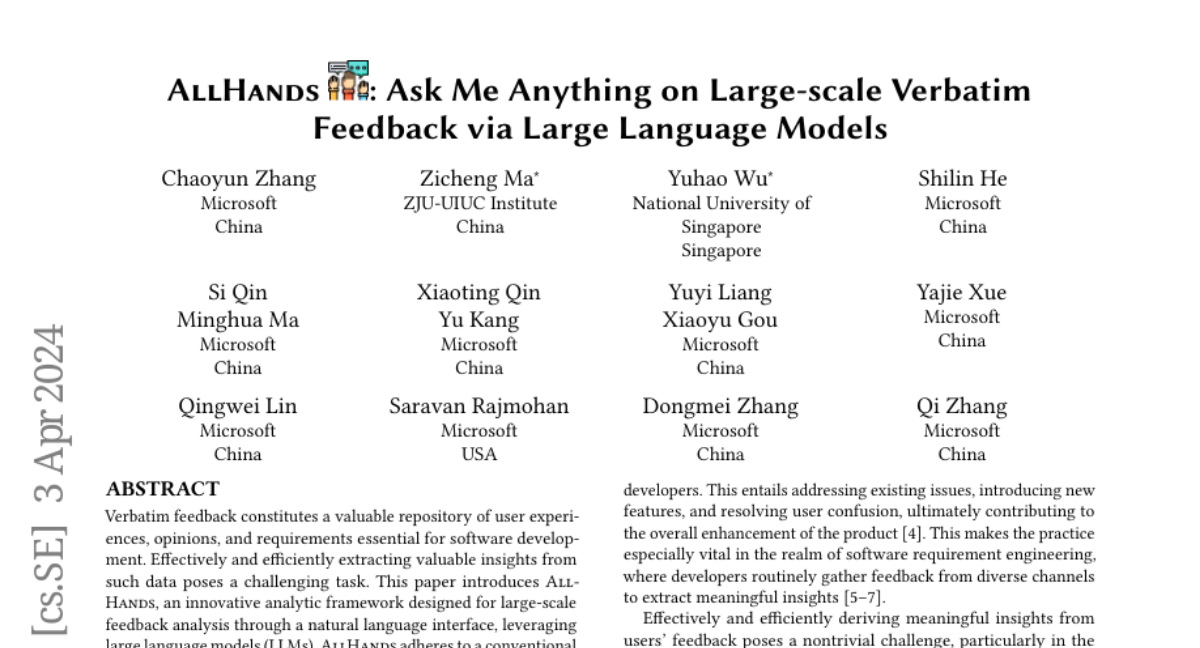
Verbatim feedback constitutes a valuable repository of user experiences, opinions, and requirements essential for software development. Effectively and efficiently extracting valuable insights from such data poses a challenging task. This paper introduces Allhands , an innovative analytic framework designed for large-scale feedback analysis through a natural language interface, leveraging large language models (LLMs). Allhands adheres to a conventional feedback analytic workflow, initially conducting classification and topic modeling on the feedback to convert them into a structurally augmented format, incorporating LLMs to enhance accuracy, robustness, generalization, and user-friendliness. Subsequently, an LLM agent is employed to interpret users' diverse questions in natural language on feedback, translating them into Python code for execution, and delivering comprehensive multi-modal responses, including text, code, tables, and images. We evaluate Allhands across three diverse feedback datasets. The experiments demonstrate that Allhands achieves superior efficacy at all stages of analysis, including classification and topic modeling, eventually providing users with an ``ask me anything'' experience with comprehensive, correct and human-readable response. To the best of our knowledge, Allhands stands as the first comprehensive feedback analysis framework that supports diverse and customized requirements for insight extraction through a natural language interface.
Compiler generated feedback for Large Language Models

We introduce a novel paradigm in compiler optimization powered by Large Language Models with compiler feedback to optimize the code size of LLVM assembly. The model takes unoptimized LLVM IR as input and produces optimized IR, the best optimization passes, and instruction counts of both unoptimized and optimized IRs. Then we compile the input with generated optimization passes and evaluate if the predicted instruction count is correct, generated IR is compilable, and corresponds to compiled code. We provide this feedback back to LLM and give it another chance to optimize code. This approach adds an extra 0.53% improvement over -Oz to the original model. Even though, adding more information with feedback seems intuitive, simple sampling techniques achieve much higher performance given 10 or more samples.